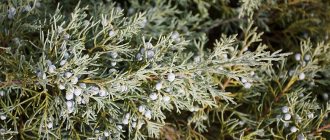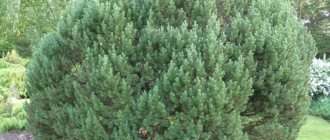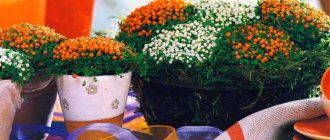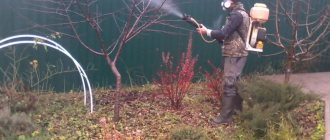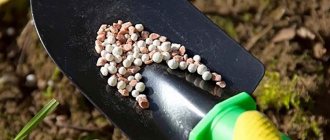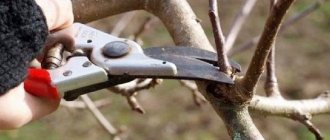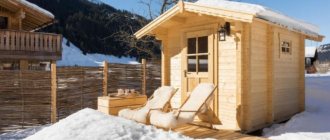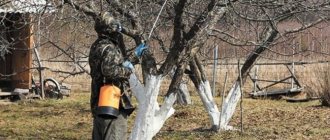Fir is a tall and durable tree. In the first years it grows slowly, but then growth accelerates. Suitable for growing in the middle zone:
- Balsam fir (Abies balsamea) variety Nana
- Compacta variety
- variety Aurea (Flava)
- variety Compacta (A. arizonica var. glauca compacta)
- variety Jan Pawel II
- Planting fir trees
Single color fir (Abies concolor)
One of the most beautiful fir trees both in the color of the needles and in the structure of the crown. The tree is native to the western regions of the United States and is often called Colorado Fir. It appeared in culture in the middle of the 19th century. The crown is dense, wide-pyramidal, the branches are horizontal. The needles are large, sometimes crescent-shaped, bluish-green.
Single-color fir variety Compacta
A slow-growing variety with a dense, wide-conical crown, up to 0.8 m high. The needles are silver-blue.
Single-color fir variety Violacea
A slow-growing tree up to 6 m high and up to 3.5 m in diameter with a wide-cone-shaped crown. The needles are soft, white and blue.
Botanical description
Fir is a monoecious plant, evergreen, heat-loving and shade-tolerant. Its root system is powerful, pivotal, and goes deep into the ground. Fir bark in young years is thin and smooth, but with age it becomes thick and cracked. The crown is cone-shaped, starting right at the base of the trunk - this is what distinguishes fir from other coniferous trees. Fir branches are arranged ring-shaped and horizontal, fir leaves are flat, entire-edged soft needles, narrowed at the base into a short petiole.
Fir needles do not acquire a dirty red hue in winter, as happens with many other conifers; each fir needle is decorated with two white stripes on the bottom. On reproductive branches the needles are pointed, on vegetative shoots they have a slightly notched or rounded tip. Male flowers look like earrings of cones, and female flowers are ovoid, cylindrical or ovoid-cylindrical, with cones sticking up (another difference between fir and other conifers, whose cones usually hang). Female fir cones consist of a rod on which cover scales sit, inside which there are fruit scales bearing two ovules. Fir trees are pollinated by the wind.
When fir seeds ripen, the scales on the cones become woody and fall off, releasing the winged seeds and leaving only the stems on the tree. In cultivation in one place, fir can live up to three hundred years.
- Daffodils - garden care
Korean fir (Abies koreana)
It grows naturally in the mountainous regions of the southern part of the Korean Peninsula. Tree up to 10–12 m tall. The needles are hard, shiny, 1.5–2 cm long. The cones are cylindrical, 5–7 cm long, in some species and forms they are purple-violet; they are also found in brown and green colors.
Korean fir
Korean fir variety Aurea (Flava)
Tree up to 7 m high with a conical crown. The needles are yellowish-green, young ones are bright yellow. Susceptible to spring burns.
Korean fir variety Aurea (Flava)
Korean fir variety Silberlocke
A popular slow-growing variety up to 4 m high with a wide-conical crown. The needles are blue-green, silvery on the underside. The buds are purple-blue.
Korean fir variety Silberlocke
Korean fir variety Grubele
A relatively new slow-growing variety of Korean fir. The needles are short and wide.
Korean fir variety Grubele
Korean fir variety Silver Star
A dwarf fir of a wide conical shape, about 1 m high at 10 years of age. The needles are short, gray-bluish, twisted, silvery-white below. The buds are purple-blue.
Korean fir variety Silver Star
Korean fir variety Tundra
A variety up to 0.6–1 m high with a dense spherical crown. The needles are quite fluffy and dense.
Use in everyday life
Oil is extracted from young needles, which is widely used in modern pharmaceuticals as a wound-healing agent. Fir oil is used to produce camphor.
- In Siberia, the population knits fir brooms for going to the bathhouse;
- Wood is used as a building material;
- Dwarf fir species are planted in parks;
- Flour is made from pine needles to feed birds and livestock.
Healers have long known about the invaluable benefits of the fir tree. Needles are a source of vitamin C. Decoctions and tinctures from it are used to boost immunity.
Subalpine fir (Abies lasiocarpa)
Fir is native to North America. In nature, the tree is 15–30 m high, in culture – up to 8 m. The needles are up to 3 cm long and up to 2 mm wide, greenish-gray, with stomatal stripes not only on the lower, but also on the upper side. Immature buds are purple-reddish.
Subalpine fir
Subalpine fir variety Compacta (A. arizonica var. glauca compacta)
A slow-growing dwarf variety with a dense crown, up to 3 m high. Short needles are silver-blue in color.
Subalpine fir variety Argentea
One of the most beautiful varieties of mountain fir. A dense coniferous tree with a conical shape, reaching a height of 8 m.
Subalpine fir variety Argentea
Reproduction
White fir reproduces both by seeds and vegetatively (by semi-lignified cuttings, layering or grafting).
Seeds can be sown before winter. For sowing in spring, they are stratified in a cold room for 1-2 months, after which they are germinated in moist, light soil at a temperature of about + 20 °C.
When propagating white fir by cuttings without the use of special stimulants, about 25% of the cuttings collected in winter take root.
Growing fir trees: all the secrets
Planting fir trees
Fir trees can be planted in spring (April) or autumn (early September). When planting, leave the root collar at ground level.
The depth of the planting hole is 60–80 cm, depending on the size of the clod. The optimal composition of the soil mixture for filling the planting hole is: leaf soil, peat and sand in a ratio of 3:1:1.
Fir care
Feed the planted plants in the spring with complex fertilizers. Firs respond favorably to regular watering with sprinkling, but cannot tolerate excessive soil moisture. It is useful to mulch the tree trunk circle with wood chips or peat in a layer of up to 8 cm.
Features of fir pruning
Fir needs sanitary pruning - removing weak and dried branches. But since the young plant stretches upward slowly, there is no need to engage in crown formation until the age of 10–15 years.
Spanish fir
Preparing for winter
It is recommended to protect young plants for the winter not so much from frost as from the sun, which causes reddening of the needles.
Green shoots
A distinctive feature of firs from other conifers is propagation by layering. The lower branches hang so low that they sprout roots when they touch the ground. After the required time, a young tree appears.
Fir is an unpretentious plant that grows well both in the shade and in the sun. It tolerates severe cold with steadfastness, preferring warmth, fertile soil and moisture. It grows well in clean air; if it is polluted, the plant may die.
Conditions of growth and distribution
It is known that Wicha fir of the Pendula variety grows on two Japanese islands: Honshu and Shikoku. The area of its growth in natural conditions is limited. But at present, Veicha is the dominant crop in the central part of Japan, where there are a large number of subalpine forests.
Usually this fir forms small forests. You can also find other trees and shrubs in them, for example, Ayan spruce, variegated hemlock, Chonoski maple, mountain ash, Erman birch. Trees adjacent to the Vicha fir can reach a height of 24 meters.
Animals also live in fir forests. The most common inhabitants are the Japanese dormouse, chamois and flying squirrel. The most common bird in such forests is the Japanese Robin.
Planting a tree
Stage 1. Preparation of planting material
| |
Stage 2. Choosing a place and time of landing
| |
Step 3: Carry out the landing
| |
Step 4: Water the plant
|
